
Mannheim Observatory
Encyclopedia
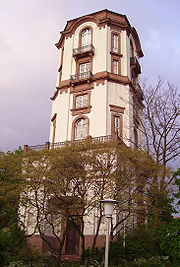
Mannheim
Mannheim is a city in southwestern Germany. With about 315,000 inhabitants, Mannheim is the second-largest city in the Bundesland of Baden-Württemberg, following the capital city of Stuttgart....
, Germany
Germany
Germany , officially the Federal Republic of Germany , is a federal parliamentary republic in Europe. The country consists of 16 states while the capital and largest city is Berlin. Germany covers an area of 357,021 km2 and has a largely temperate seasonal climate...
, which remained in operation until 1880. The observatory was transferred to Karlsruhe
Karlsruhe
The City of Karlsruhe is a city in the southwest of Germany, in the state of Baden-Württemberg, located near the French-German border.Karlsruhe was founded in 1715 as Karlsruhe Palace, when Germany was a series of principalities and city states...
and finally in 1898, was established on the Königstuhl
Königstuhl (Odenwald)
The Königstuhl , translated "Kings seat", is a 567 metre high hill in the Odenwald Mountains and in the city of Heidelberg, in the German state of Baden-Württemberg. The Königstuhl summit allows visitors a spectacular view of the city of Heidelberg and the River Neckar as well as the Rhine Valley...
near Heidelberg
Heidelberg
-Early history:Between 600,000 and 200,000 years ago, "Heidelberg Man" died at nearby Mauer. His jaw bone was discovered in 1907; with scientific dating, his remains were determined to be the earliest evidence of human life in Europe. In the 5th century BC, a Celtic fortress of refuge and place of...
where today’s successor institution thr State Observatory Heidelberg-Königstuhl is located.
The observatory tower is now owned by the city and was restored in 1905-1906, and after the Second World War. Since 1958, the tower houses studio flats.
Schwetzingen
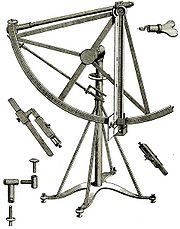
Prince-elector
The Prince-electors of the Holy Roman Empire were the members of the electoral college of the Holy Roman Empire, having the function of electing the Roman king or, from the middle of the 16th century onwards, directly the Holy Roman Emperor.The heir-apparent to a prince-elector was known as an...
Karl Theodor
Charles Theodore, Elector of Bavaria
Charles Theodore, Prince-Elector, Count Palatine and Duke of Bavaria reigned as Prince-Elector and Count palatine from 1742, as Duke of Jülich and Berg from 1742 and also as Prince-Elector and Duke of Bavaria from 1777, until his death...
was a prince of the Age of Enlightenment
Age of Enlightenment
The Age of Enlightenment was an elite cultural movement of intellectuals in 18th century Europe that sought to mobilize the power of reason in order to reform society and advance knowledge. It promoted intellectual interchange and opposed intolerance and abuses in church and state...
. The French thinker Voltaire
Voltaire
François-Marie Arouet , better known by the pen name Voltaire , was a French Enlightenment writer, historian and philosopher famous for his wit and for his advocacy of civil liberties, including freedom of religion, free trade and separation of church and state...
was a frequent visitor to his Court, the Elector made numerous reforms during his reign and founded scientific institutions. The Physics
Physics
Physics is a natural science that involves the study of matter and its motion through spacetime, along with related concepts such as energy and force. More broadly, it is the general analysis of nature, conducted in order to understand how the universe behaves.Physics is one of the oldest academic...
Institute, established in 1751 in Heidelberg
Heidelberg
-Early history:Between 600,000 and 200,000 years ago, "Heidelberg Man" died at nearby Mauer. His jaw bone was discovered in 1907; with scientific dating, his remains were determined to be the earliest evidence of human life in Europe. In the 5th century BC, a Celtic fortress of refuge and place of...
, had as its Professor of Experimental Physics
Physics
Physics is a natural science that involves the study of matter and its motion through spacetime, along with related concepts such as energy and force. More broadly, it is the general analysis of nature, conducted in order to understand how the universe behaves.Physics is one of the oldest academic...
and Mathematics
Mathematics
Mathematics is the study of quantity, space, structure, and change. Mathematicians seek out patterns and formulate new conjectures. Mathematicians resolve the truth or falsity of conjectures by mathematical proofs, which are arguments sufficient to convince other mathematicians of their validity...
the Jesuit Father Christian Mayer.
In 1756 Mayer was sent to Paris
Paris
Paris is the capital and largest city in France, situated on the river Seine, in northern France, at the heart of the Île-de-France region...
to study the local water supply, he also studied at one of the centres of contemporary astronomy
Astronomy
Astronomy is a natural science that deals with the study of celestial objects and phenomena that originate outside the atmosphere of Earth...
. He was given an Astronomical Quadrant
Quadrant (instrument)
A quadrant is an instrument that is used to measure angles up to 90°. It was originally proposed by Ptolemy as a better kind of astrolabe. Several different variations of the instrument were later produced by medieval Muslim astronomers.-Types of quadrants:...
, by the instrument maker, Canivet. In 1759, he observed the return of the comet predicted by Edmond Halley
Edmond Halley
Edmond Halley FRS was an English astronomer, geophysicist, mathematician, meteorologist, and physicist who is best known for computing the orbit of the eponymous Halley's Comet. He was the second Astronomer Royal in Britain, following in the footsteps of John Flamsteed.-Biography and career:Halley...
.
Transit of Venus 1761/1769
Mayer observed the TransitTransit of Venus
A transit of Venus across the Sun takes place when the planet Venus passes directly between the Sun and Earth, becoming visible against the solar disk. During a transit, Venus can be seen from Earth as a small black disk moving across the face of the Sun...
of Venus across the Sun
Sun
The Sun is the star at the center of the Solar System. It is almost perfectly spherical and consists of hot plasma interwoven with magnetic fields...
on 6 June 1761 from a temporary Observatory
Observatory
An observatory is a location used for observing terrestrial or celestial events. Astronomy, climatology/meteorology, geology, oceanography and volcanology are examples of disciplines for which observatories have been constructed...
built of wood by Karl Theodor in the Orangery
Orangery
An orangery was a building in the grounds of fashionable residences from the 17th to the 19th centuries and given a classicising architectural form. The orangery was similar to a greenhouse or conservatory...
in the park of Schwetzingen Castle
Schwetzingen Castle
Schloss Schwetzingen, or Schwetzingen Castle is a palace in the German state of Baden-Württemberg. Schwetzingen was the summer residence of the Electors Palatine Karl III Philip and Charles Theodore. It is situated in Schwetzingen, roughly equidistant from the electors' seats at Heidelberg and...
. The observations convinced the elector as early as July to begin work on an observatory building on the palace roof, which was inaugurated in 1764.
A few years later, Mayer travelled for a year to St. Petersburg and observed there, another Transit of Venus
Transit of Venus
A transit of Venus across the Sun takes place when the planet Venus passes directly between the Sun and Earth, becoming visible against the solar disk. During a transit, Venus can be seen from Earth as a small black disk moving across the face of the Sun...
on 3 June 1769. The Schwetzinger observatory was not unused, however. Carl Theodor and a visitor, Prince Franz Xavier of Saxony
Franz Xavier of Saxony
Franz Xavier of Saxony , was a German prince and member of the House of Wettin.He was the fourth but second surviving son of Augustus III, King of Poland and Elector of Saxony, and Maria Josepha of Austria.-Regent of Saxony:His older brother, the Elector Frederick Christian, died on 17 December...
, wished to observe the phenomenon, but were unsuccessful due to bad weather.
Mayer published his results from the two Venus Transits in St. Petersburg and calculated, with the help of his observations of the two transits, that the average Earth-Sun distance was 146.2 million kilometers, which is only three million kilometers less than the actual value, however, with a significant measurement uncertainty.
The Founding of the Mannheim Observatory
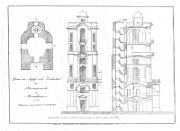
Mannheim Palace
Mannheim Palace is a large Baroque palace in Mannheim, Baden-Württemberg, Germany. It was originally the main residence of the Prince-electors of the Electoral Palatinate...
, in the vicinity of the Jesuit College
Jesuit Church (Mannheim)
The Mannheim Jesuit Church is a church in Mannheim, Germany.-History:The church was built between 1733 in 1756 as the Court Church of the Mannheim electors Charles Philip III and Charles Theodore to a design of the Italian architect Alessandro Galli da Bibiena. It was completed in 1760 and...
was laid. In the following years Mayer acquired numerous instruments and with the help of books delivered from the Electoral Library made the Mannheim Observatory into an internationally known research facility.
In the visitors book of the Mannheim observatory not only are there entries by many well-known colleagues, but also illustrious guests such as Wolfgang Amadeus Mozart
Wolfgang Amadeus Mozart
Wolfgang Amadeus Mozart , baptismal name Johannes Chrysostomus Wolfgangus Theophilus Mozart , was a prolific and influential composer of the Classical era. He composed over 600 works, many acknowledged as pinnacles of symphonic, concertante, chamber, piano, operatic, and choral music...
, Benjamin Franklin
Benjamin Franklin
Dr. Benjamin Franklin was one of the Founding Fathers of the United States. A noted polymath, Franklin was a leading author, printer, political theorist, politician, postmaster, scientist, musician, inventor, satirist, civic activist, statesman, and diplomat...
, Envoy
Envoy (title)
In diplomacy, an Envoy Extraordinary and Minister Plenipotentiary is, under the terms of the Congress of Vienna of 1815, a diplomat of the second class, ranking between an Ambassador and a Minister Resident....
of the young United States
United States
The United States of America is a federal constitutional republic comprising fifty states and a federal district...
, and even Arabic and other writings.
Mayer's astronomical work found its peak in the discovery of Binary Star
Binary star
A binary star is a star system consisting of two stars orbiting around their common center of mass. The brighter star is called the primary and the other is its companion star, comes, or secondary...
s. The majority of the binary stars published in Bode's
Johann Elert Bode
Johann Elert Bode was a German astronomer known for his reformulation and popularization of the Titius-Bode law. Bode determined the orbit of Uranus and suggested the planet's name.-Biography:...
star chart
Star chart
A star chart is a map of the night sky. Astronomers divide these into grids to use them more easily. They are used to identify and locate astronomical objects such as stars, constellations and galaxies. They have been used for human navigation since time immemorial...
of 1782 were observed by Mayer.
Elector Karl Theodor left the Palatinate in 1778, to govern Bavaria
Bavaria
Bavaria, formally the Free State of Bavaria is a state of Germany, located in the southeast of Germany. With an area of , it is the largest state by area, forming almost 20% of the total land area of Germany...
. Not least because of the absence of a personal patron prince the history of the observatory after the death of Christian Mayer in 1783 was less happy.
Christian Mayer’s Successors
The new Court Astronomer, the Jesuit Karl König, was transferred to Munich by the Elector Karl Theodor soon after he arrived in Mannheim, the next, the ex-Jesuit John Fischer, made so many enemies that in 1788 after only a year and a half he resigned. The Vincentian priestLazarists
Congregation of the Mission is a vowed order of priests and brothers associated with the Vincentian Family, a loose federation of organizations who claim St. Vincent de Paul as their founder or Patron...
Peter Ungeschick was probably a better choice, but in 1790 he died on the return journey from studying in Paris. He was followed by Roger Barry, also a member of the Order of Vincentians.
Barry’s initial successes were undone by the wars of the Napoleonic Era during which severe damage was inflicted on the Observatory. The tower was repeatedly shelled, instruments were destroyed and others damaged. Some disappeared in unexplained ways. Barry was imprisoned for a time by the French, although he was given the opportunity to observe a Transit of Mercury
Transit of Mercury
A transit of Mercury across the Sun takes place when the planet Mercury comes between the Sun and the Earth, and Mercury is seen as a small black dot moving across the face of the Sun....
, but little else.
From the Napoleonic Wars to the German Revolution
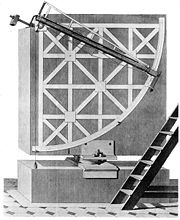
Grand duchy
A grand duchy, sometimes referred to as a grand dukedom, is a territory whose head of state is a monarch, either a grand duke or grand duchess.Today Luxembourg is the only remaining grand duchy...
of Baden
Baden
Baden is a historical state on the east bank of the Rhine in the southwest of Germany, now the western part of the Baden-Württemberg of Germany....
's claims to areas of the Palatinate and thus the observatory, the Court Astronomer, Roger Barry, recommenced his observations, but fell ill in 1810 and the observatory remained unused until his death in 1813. His numerous observations with the Mural Quadrant
Mural instrument
A mural instrument is an angle measuring device mounted on or built into a wall. For astronomical purposes, these walls were oriented so they lie precisely on a meridian. A mural instrument that measured angles from 0 to 90 degrees was called a mural quadrant.-Construction:Many older mural...
made after 1800 remained unpublished, by his successors as they were not classified.
The running of the Mannheim Observatory by Catholic Orders was now over. In the years up to the Baden Revolution in 1848 the observatory declined. Famous astronomers were either not retained, such as Heinrich Christian Schumacher
Heinrich Christian Schumacher
Heinrich Christian Schumacher was a German-Danish astronomer.-Biography:He was born at Bramstedt, in Holstein, and studied at Kiel, Jena, Copenhagen, and Göttingen. In 1810, he became adjunct professor of astronomy in Copenhagen...
(Director 1813-1815), founder of the oldest existing journal of astronomy,Astronomische Nachrichten
Astronomische Nachrichten
Astronomische Nachrichten , one of the first international journals in the field of astronomy, was founded in 1821 by the German astronomer Heinrich Christian Schumacher. It claims to be the oldest astronomical journal in the world that is still being published...
, and the faculty at Altona. Friedrich Wilhelm Struve
Friedrich Georg Wilhelm von Struve
Friedrich Georg Wilhelm von Struve was a Danish-Baltic German astronomer from a famous dynasty.-Life:...
, founder and first director of Pulkovo Observatory
Pulkovo Observatory
The Pulkovo Astronomical Observatory астрономи́ческая обсервато́рия Росси́йской акаде́мии нау́к), the principal astronomical observatory of the Russian Academy of Sciences, located 19 km south of Saint Petersburg on Pulkovo Heights...
at St. Petersburg, despite being interested was deterred by clumsy personnel policy. From 1816 until his death in 1846 Bernhard Nicolai
Friedrich Bernhard Gottfried Nicolai
Friedrich Bernhard Gottfried Nicolai was a German astronomer.Born in Braunschweig, Nicolai was educated at Göttingen. In 1812, he calculated the Euler–Mascheroni constant to 40 decimal places. In 1816, he joined the Mannheim observatory where he became the director.The crater Nicolai on the Moon...
was Court Astronomer, being mainly dedicated to the orbits of comets. In his time, amongst other things, a three stage refracting telescope
Refracting telescope
A refracting or refractor telescope is a type of optical telescope that uses a lens as its objective to form an image . The refracting telescope design was originally used in spy glasses and astronomical telescopes but is also used for long focus camera lenses...
was purchased from Fraunhofer
Joseph von Fraunhofer
Joseph von Fraunhofer was a German optician. He is known for the discovery of the dark absorption lines known as Fraunhofer lines in the Sun's spectrum, and for making excellent optical glass and achromatic telescope objectives.-Biography:Fraunhofer was born in Straubing, Bavaria...
, which was later used by the German expeditions of 1874 and 1882 to observe The Transit of Venus.
The instruments and the Observatory Tower itself were ageing. Already mature plans for construction of a new observatory drawn up in the revolutionary period were no longer to be, and on 10 June 1850 it was decided to the Institute by appointing no new Court Astronomer. In 1852 the Heidelberg
Heidelberg
-Early history:Between 600,000 and 200,000 years ago, "Heidelberg Man" died at nearby Mauer. His jaw bone was discovered in 1907; with scientific dating, his remains were determined to be the earliest evidence of human life in Europe. In the 5th century BC, a Celtic fortress of refuge and place of...
professor Nell took over the unpaid supervision of the institute. In 1859 this modest institute planned renewal with the purchase of a six stage telescope
Telescope
A telescope is an instrument that aids in the observation of remote objects by collecting electromagnetic radiation . The first known practical telescopes were invented in the Netherlands at the beginning of the 1600s , using glass lenses...
.
Move to Karlsruhe
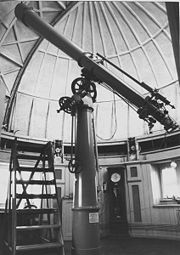
Eduard Schönfeld
Eduard Schönfeld was a German astronomer.-Education:Schönfeld was born at Hildburghausen, in the Duchy of Saxe-Meiningen, where he had a distinguished career at the gymnasium. On leaving the gymnasium, he desired to devote himself to astronomy, but abandoned the idea in deference to his father's...
was appointed Director with a salary. The observatory equipment at his disposal was somewhat antiquated, his largest telescope being a small refractor of 73 lines aperture
Aperture
In optics, an aperture is a hole or an opening through which light travels. More specifically, the aperture of an optical system is the opening that determines the cone angle of a bundle of rays that come to a focus in the image plane. The aperture determines how collimated the admitted rays are,...
, but he selected a line of work to suit the instruments at his disposal, observing Nebula
Nebula
A nebula is an interstellar cloud of dust, hydrogen gas, helium gas and other ionized gases...
e, for which he soon made a name for himself, and variable stars and keeping a watch on comets and new planets.
The results of his observations of nebulae are contained in two catalogues published in the Astronomische Beobachtungen der Grossherzoglichen Sternwarte zu Mannheim, 1st and 2nd parts (1862 and 1875), and those of his variable star observations appeared in the Jahresberichte des Mannheimer Vereins für Naturkunde, Nos. 32 and 39 (1866 and 1875). His work contributed significantly to the "Bonn Survey", a star catalogue still in use today. Moreover, he organized several astronomical meetings. At one such a meeting, 28 August 1863 in Heidelberg, the Astronomische Gesellschaft
Astronomische Gesellschaft
The Astronomische Gesellschaft is an astronomical society established in 1863 in Heidelberg, the second oldest astronomical society after the Royal Astronomical Society....
, the second oldest astronomical society after the Royal Astronomical Society
Royal Astronomical Society
The Royal Astronomical Society is a learned society that began as the Astronomical Society of London in 1820 to support astronomical research . It became the Royal Astronomical Society in 1831 on receiving its Royal Charter from William IV...
. was founded. Schönfeld was on the founding board. Among many other activities, he was a member of the 1871 Advisory Commission in preparation for the 1874/82 Transits of Venus.
Schönfeld left for Bonn
Bonn
Bonn is the 19th largest city in Germany. Located in the Cologne/Bonn Region, about 25 kilometres south of Cologne on the river Rhine in the State of North Rhine-Westphalia, it was the capital of West Germany from 1949 to 1990 and the official seat of government of united Germany from 1990 to 1999....
in 1875 and Karl Wilhelm Valentiner
Karl Wilhelm Valentiner
Karl Wilhelm Valentiner was a German astronomer.-Life:In 1874, Wilhelm Valentiner lead a successful German expedition to Tschifu to observe a solar eclipse. 1875, He took over the directorship of the Mannheim Observatory in 1875...
took over the Mannheim Directorship. The location of the Observatory in the middle of the town was no longer suitable. The Observatory was moved to a makeshift building in Karlsruhe in 1880 but no significant observations were made. Plans to build a permanent observatory in Karlsruhe did not become a reality, very much to Valentine’s annoyance, even though the first telescopes and instruments were purchased.
During that time the desire for an observatory arose at the University of Heidelberg. The young Heidelberg
Heidelberg
-Early history:Between 600,000 and 200,000 years ago, "Heidelberg Man" died at nearby Mauer. His jaw bone was discovered in 1907; with scientific dating, his remains were determined to be the earliest evidence of human life in Europe. In the 5th century BC, a Celtic fortress of refuge and place of...
astronomer Max Wolf
Max Wolf
Maximilian Franz Joseph Cornelius Wolf was a German astronomer and a pioneer in the field of astrophotography...
had already built a private observatory in his parents' house in 1880. He believed firmly in the use of photography
Photography
Photography is the art, science and practice of creating durable images by recording light or other electromagnetic radiation, either electronically by means of an image sensor or chemically by means of a light-sensitive material such as photographic film...
for observation and as a result he quickly made a name for himself in astronomy.
The Mountain Observatory at Heidelberg
In 1892 a deputation of Heidelberg professors, amongst them Max Wolf, petitioned the Grand Duke of Karlsruhe for a University research and teaching observatory. This was not financially feasible at that time for BadenBaden
Baden is a historical state on the east bank of the Rhine in the southwest of Germany, now the western part of the Baden-Württemberg of Germany....
which could do little more than construct the buildings, and could not afford the instruments for Wolf’s specialisation of astrophotography
Astrophotography
Astrophotography is a specialized type of photography that entails recording images of astronomical objects and large areas of the night sky. The first photographs of an astronomical object were taken in the 1840s, but it was not until the late 19th century that advances in technology allowed for...
. Wolf sought supporters for the purchase of new telescopes. The search proved to be very successful: Catherine Wolfe Bruce
Catherine Wolfe Bruce
Catherine Wolfe Bruce was a noted American philanthropist and patroness of astronomy.She was the daughter of the famous type founder George Bruce and Catherine Wolfe...
, the noted American philanthropist and patroness of science, donated $10,000 for a telescope, and this donation was followed by others. Finally, on the construction of an observatory it was granted that the Karlsruhe instruments should be transferred to Heidelberg.
On 20 June 1898 the "Großherzogliche Bergsternwarte" at Königstuhl (the present day Heidelberg Observatory) was ceremonially inaugurated by Frederick I, Grand Duke of Baden. The astronomical institute comprised two competing departments, the Astrophysics
Astrophysics
Astrophysics is the branch of astronomy that deals with the physics of the universe, including the physical properties of celestial objects, as well as their interactions and behavior...
Department under Max Wolf
Max Wolf
Maximilian Franz Joseph Cornelius Wolf was a German astronomer and a pioneer in the field of astrophotography...
, containing the instruments from his private observatory and the new foundation's instruments, and the Astrometry
Astrometry
Astrometry is the branch of astronomy that involves precise measurements of the positions and movements of stars and other celestial bodies. The information obtained by astrometric measurements provides information on the kinematics and physical origin of our Solar System and our Galaxy, the Milky...
Department under Karl Wilhelm Valentiner
Karl Wilhelm Valentiner
Karl Wilhelm Valentiner was a German astronomer.-Life:In 1874, Wilhelm Valentiner lead a successful German expedition to Tschifu to observe a solar eclipse. 1875, He took over the directorship of the Mannheim Observatory in 1875...
, containing the Karlsruhe instruments. Valentiner was director of the Mannheim Observatory and had initiated the move to Karlsruhe. After Valentiner's retirement in 1909, both departments were amalgamated under the administration of Max Wolf.
Wolf worked on many areas of astrophysics, he investigated the structure of the Milky Way
Milky Way
The Milky Way is the galaxy that contains the Solar System. This name derives from its appearance as a dim un-resolved "milky" glowing band arching across the night sky...
, star
Star
A star is a massive, luminous sphere of plasma held together by gravity. At the end of its lifetime, a star can also contain a proportion of degenerate matter. The nearest star to Earth is the Sun, which is the source of most of the energy on Earth...
spectroscopy
Spectroscopy
Spectroscopy is the study of the interaction between matter and radiated energy. Historically, spectroscopy originated through the study of visible light dispersed according to its wavelength, e.g., by a prism. Later the concept was expanded greatly to comprise any interaction with radiative...
and gas nebula, and searched intensively for Asteroid
Asteroid
Asteroids are a class of small Solar System bodies in orbit around the Sun. They have also been called planetoids, especially the larger ones...
s, of which he discovered more than 800. As an honorary citizen of Heidelberg, he was buried in the cemetery on the mountain in 1932.
After the Second World War, there was a new beginning for the Institute, now named the Königstuhl State Observatory (LSW). In 1983 the Mannheim instruments were donated to the State Museum of Technology and Industry in Mannheim, where some of them now form part of the permanent exhibition. The 1859 six stage telescope was give to the city of Karlsruhe in 1957 for the establishment of the Public Astronomical Observatory of Karlsruhe, another instrument was given to the National Astronomical Observatory Heppenheim
Heppenheim
Heppenheim is the seat of Bergstraße district in Hesse, Germany, lying on the Bergstraße on the edge of the Odenwald.- Location :...
. The valuable book collection of the old library, the oldest of which dates back 1476, was transferred to the Manuscript Department of the University Library.
Sources
- Kai Budde: Sternwarte Mannheim. Die Geschichte der Mannheimer Sternwarte 1772–1880. Technik + Arbeit 12. Schriften des Landesmuseums für Technik und Arbeit in Mannheim. Ubstadt-Weiher, verlag regionalkultur 2006. ISBN 978-3-89735-473-9. 200 S. mit 76, meist farbigen Abb., fester Einband.
- Alexander Moutchnik, Forschung und Lehre in der zweiten Hälfte des 18. Jahrhunderts. Der Naturwissenschaftler und Universitätsprofessor Christian Mayer SJ (1719-1783) (Algorismus, Studien zur Geschichte der Mathematik und der Naturwissenschaften, Bd. 54), Erwin Rauner Verlag, Augsburg, 523 Seiten mit 8 Tafeln, 2006. ISBN 3-936905-16-9 http://www.erwin-rauner.de/algor/ign_publ.htm#H54 Inhaltsverzeichnis: http://www.ulb.tu-darmstadt.de/tocs/178692786.pdf
- Thomas Schoch: Die Sternwarte Mannheim und ihr Hofastronom Christian Mayer 1763-1783, 1986, Universität Mannheim, im Stadtarchiv

